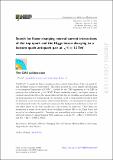Search for flavor-changing neutral current interactions of the top quark and the Higgs boson decaying to a bottom quark-antiquark pair at s $$ \sqrt{s} $$ = 13 TeV
Author(s)
Tumasyan, A.; Adam, W.; Andrejkovic, J. W.; Bergauer, T.; Chatterjee, S.; Damanakis, K.; Dragicevic, M.; Escalante Del Valle, A.; Frühwirth, R.; Jeitler, M.; Krammer, N.; Lechner, L.; Liko, D.; Mikulec, I.; Paulitsch, P.; ... Show more Show less
Download13130_2022_Article_17854.pdf (1.789Mb)
Publisher with Creative Commons License
Publisher with Creative Commons License
Creative Commons Attribution
Terms of use
Metadata
Show full item recordAbstract
Abstract
A search for flavor-changing neutral current interactions of the top quark (t) and the Higgs boson (H) is presented. The search is based on a data sample corresponding to an integrated luminosity of 137 fb−1 recorded by the CMS experiment at the LHC in proton-proton collisions at
s
$$ \sqrt{s} $$
= 13 TeV. Events containing exactly one lepton (muon or electron) and at least three jets, among which at least two are identified as originating from the hadronization of a bottom quark, are analyzed. A set of deep neural networks is used for kinematic event reconstruction, while boosted decision trees distinguish the signal from the background events. No significant excess over the background predictions is observed, and upper limits on the signal production cross sections are extracted. These limits are interpreted in terms of top quark decay branching fractions (
B
$$ \mathcal{B} $$
) to the Higgs boson and an up (u) or a charm quark (c). Assuming one nonvanishing extra coupling at a time, the observed (expected) upper limits at 95% confidence level are
B
$$ \mathcal{B} $$
(t → Hu) < 0.079 (0.11)% and
B
$$ \mathcal{B} $$
(t → Hc) < 0.094 (0.086)%.
Date issued
2022-02-21Department
Massachusetts Institute of Technology. Department of PhysicsPublisher
Springer Berlin Heidelberg
Citation
Journal of High Energy Physics. 2022 Feb 21;2022(2):169
Version: Final published version